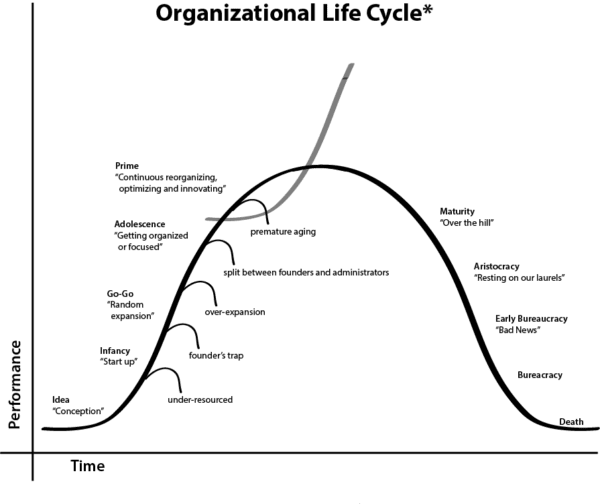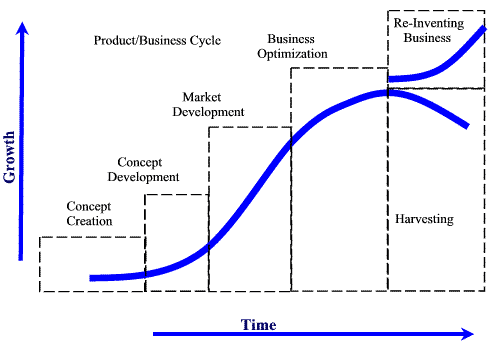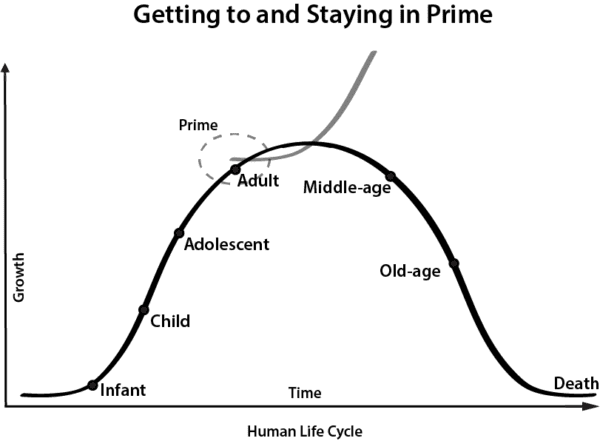One can say that everything has a growth cycle, particularly when we refer to living organisms. However, we can also state that every system designed by humans has a growth cycle. Whatever we create reflects who we are. Therefore, individuals, teams, organizations and even products or services reflect a similar growth and decline cycle.
The most familiar growth or maturation cycle is that of a human being. As depicted in the bell-shaped graph below, we develop from birth through infancy-childhood-adolescence-adulthood-middle age into old age and eventually death. The transition from birth to death is a universal human experience. What remains unique for each human are the choices made and the maturation developed at each stage.
Most humans feel they reach their prime from adulthood to middle age, and the metaphorical way we as humans “stay in prime” is through continuous learning and procreation. We birth children and teach them what we learn hoping to enlighten and advance both ourselves and this next generation.
The life cycle of a team is typically not depicted along the same bell-shaped curve, however the stages of team development follow a similar path. The team is birthed and comes together in its Forming stage where the focus is on orientation, introductions and inclusion. Team member behaviour is initially polite as similarities are recognized but moves to greater frustration as differences become more obvious.
This catapults the team into a Storming stage where some form of control and order is sought through agreement on what and how decisions will be made. Success at collaboration and decision making deepens the team’s ability to negotiate, coordinate and balance their task and relationship demands. The team’s Norming process solidifies the genuine affection and skill cohesion required to optimize its productivity and elevate itself into its prime, that of a high-performing body.
Although the life of a team (i.e., the New York Mets) can extend far beyond any of its members’ longevity, to stay in prime a team must Transform itself whenever its members or mandate changes. Strategies for teams to stay in prime or rebuild from decline include bringing in new members and knowledge-skill sets, redesigning and refining team processes, and reinventing the team’s mandate or reason for existing.
Although the degree and amount of complexity increases within organizations, their life cycle follows a similar maturation curve to that of a team or individual. As depicted below,

an idea is conceived which, with the founders’ energy and commitment, becomes a start-up operation. In its infancy, the organization’s focus is on doing and the founders are frantic to produce the necessary resources to fund further growth. If this action orientation produces results, the organization goes through an expansion phase (Go-Go) where any and all opportunities are pursued.
Eventually, priorities need to be set based on limited resources and time so a decision point (Adolescence) is reached when the organization recognizes it requires focus and coordination to avoid over-extending itself. Administrative and coordination systems are established to stabilize the organization. At the same time that energy is required to produce and improve results, energy is also needed to take on new opportunities (to birth new product or service lines).
It is this balancing act between optimizing stability (maximizing core business improvements) and continually innovating (adapting new products/services to eventually become core business practices) that feeds the organizational engine and keeps it in Prime. Of course, when the organizational scales tip in favour of administrative stability over innovation, death by bureaucracy is the final outcome.
From a product development perspective, we again witness this familiar life cycle of introduction, growth, maturity and decline. As portrayed in the graph below, the Introductory phase encompasses concept creation and product development. Without the commitment and energy to grow its market and increase its return on investment, the product can die at this stage.
During the product’s Growth phase, demand for it increases distribution as well as competition and significant energy goes into optimizing return on investment (ROI) through improvements, spinoffs and/or support services. With increased revenues and market share, any growth product appeals to competitors. These competitors increase in numbers as their duplicated offerings appear in new and existing markets. Sales of the product reach their peak during the Mature phase even with lower competitor pricing and lower profit margins (due to market saturation). When product profits equal expenses, the shift to Decline has emerged and the product is removed from the market place freeing corporate resources to support new offerings.

No matter whether you are self-employed, a member of a project team or an employee in someone else’s organization, you are subject to familiar and similar forces requiring you to optimize the strengths of your current offerings while you anticipate and invest in new possibilities for contributing and accruing ROI.
Ask yourself, “Where is my industry located on the growth life cycle – Introductory, Growth, Maturity or Decline?” If your industry has reached its maturity or is already in decline, what strengths, knowledge and skills can you transfer to new possibilities?






